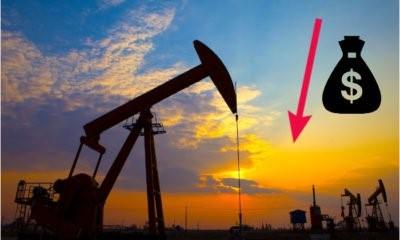The profitability of the oil industry
A review of effects of the COVID-19 crisis on the oil industry: world supply and demand, prices, loss of profitability and variables related to change in the energy matrix.
- Análisis

The crisis over COVID-19 has hit the world economy as a whole. This note will review the effects on the oil industry, the fall in the volume of world supply and demand, and the prices of crude oil quoted on international markets, especially the West Texas Intermediate (WTI). It will also explain the loss of profitability in the industry and some variables not considered related to the change in the energy matrix.
The International Energy Agency estimates that global demand for crude oil fell in volume in April, i.e. it will represent values of a decade ago during the course of this year. As for supply, it has been reduced through an OPEC+ agreement, which includes other producers such as Russia, the US, Mexico and Canada, for a cut of approximately 9.7 million barrels per day in May and June, the deepest cut ever agreed by the world's oil producers. The group will then steadily increase production until the agreement expires in April 2022.
After the agreement, WTI prices fell to negative levels, reaching minus $40 on oil futures that expired on April 21. This price also affected the other oil indices such as Brent; it showed that there is nowhere to deposit the oil, and it is unlikely that reactivation of supply will happen soon. The Norwegian energy consultant Rystad estimated that “[...] given the oversupply in the market since then, as of 21 April, the market may only have about ten days of practical onshore storage capacity left for crude oil”.
The meager price has particularly affected the US industry, which did not significantly cut back on its oil production. The Energy Information Administration's weekly data for the first week of April showed that the U.S. oil industry was still pumping 13 million barrels of crude oil a day, just below production peaks. Gasoline demand fell from 9.2 m/b/d to 6.7 m/b/d between the first week of April 2019 and the same week in April 2020, leaving a growing stockpile. The market will recover in terms of demand when the contingency passes, and economic activity becomes regularized. The long-term price trend is, however, still negative for this sector (more information).
Production is expensive, and obtaining profitability at low prices is extremely difficult for a large number of companies related to the sector. As a result, several oil companies have filed for bankruptcy. Callon Petroleum (NYSE: CPE), Chesapeake Energy (NYSE: CHK), Diamond Offshore (NYSE: DO), and Occidental Petroleum (NYSE: OXY) will probably file for bankruptcy in 2020.
An oil industry recovery will depend on price improvement and the speed with which it happens. Prices will probably remain low, and the sector will suffer despite the market recovery. Given the possible bankruptcies of small and medium-sized companies, this will lead to an increase in the concentration of supply. Equally, there will be a fall in profits in State-owned oil companies, which will not go bankrupt because of the support of their governments.
Because of this negative environment in the industry, the possibility of more significant investment in alternative energies and consequently, a deepening of the change in the energy matrix can happen. China and its leadership in photovoltaic energy, in particular, have invested in renewable projects and benefits from the boom in the electric car sector in that country; as a substitute for fossil fuels.
In addition to China, the EU has taken the threats of climate change seriously and has, therefore, proposed to phase out the oil energy matrix. By 2030, it is expected that on average renewable energies will represent about 30% of the total consumed (more information). Countries such as Sweden, which in 2017 obtained 55% of its electricity from renewable sources, Finland, Latvia, Denmark, Austria, Montenegro, and Albania, get energy from renewable sources at a rate of more than 30%. Even the world's largest oil producer, Saudi Arabia, has launched a mechanism to offer loans to projects and manufacturers of components related to alternative energy.
The oil industry is going through both a cyclical and structural crisis. The market will recover in a short time, although prices will remain low, as well as profitability low. The current crisis and the fall in prices complicate the scenario for investment in alternative energy sources, even though these will replace oil and other fossil fuels in much of the world in the medium term. In view of the current climate crisis, however, it is urgent to continue consolidating projects to make energy clean and oil obsolete.
Num.12, Año 2020, May 1st 2020
- Oscar Ugarteche, Senior Researcher "C", IIEc-UNAM, SNI III Conacyt, obela.org coordinator
- Arturo Martínez Paredes, Faculty of Economics, UNAM, Member of obela.org
Source: OBELA, Observatorio Económico Latinoamericano. www.obela.org
Del mismo autor
- El multilateralismo bipolar 08/03/2022
- Bipolar multilateralism 07/03/2022
- What does 2022 bring? Uncertainty 31/01/2022
- ¿Qué trae el 2022? Incertidumbre 31/01/2022
- The most expensive Christmas of the century... (so far) 20/01/2022
- La navidad más cara del siglo (hasta ahora) 20/01/2022
- Lo que pasó en el 2021 10/01/2022
- What happened in 2021 10/01/2022
- Estados Unidos: el elefante en la habitación 08/11/2021
- The elephant in the room 07/11/2021
Clasificado en
Clasificado en:
Crisis Económica
- Geraldina Colotti 07/04/2022
- Julio C. Gambina 07/04/2022
- Rafael Bautista S. 06/04/2022
- Julio Gambina 04/04/2022
- José Ramón Cabañas Rodríguez 01/04/2022
Pandemia
- Gabriela Ramírez Mendoza 07/02/2022
- Jyotsna Singh 06/02/2022
- Gabriela Ramírez Mendoza 06/02/2022
- Richa Chintan 10/01/2022
- Isaac Enríquez Pérez 03/01/2022
